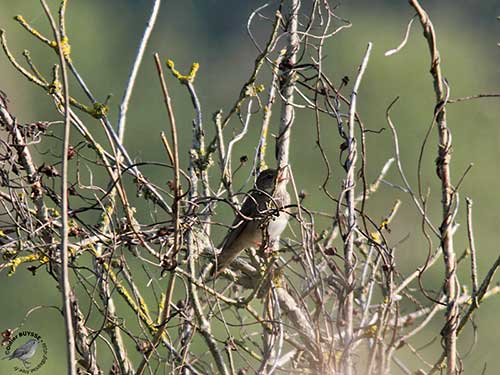
Fr: Locustelle fluviatile
Ang: River Warbler - Eurasian River Warbler
All: Schlagschwirl
Esp: Buscarla Fluvial
Ita: Locustella fluviatile
Nd: Krekelzanger
Sd: flodsångare
Photographers:
Didier Buysse
Vision d’Oiseaux
Ingo Waschkies
Bird Photography
Text by Nicole Bouglouan
Sources :
HANDBOOK OF THE BIRDS OF THE WORLD Vol 11 by Josep del Hoyo, Andrew Elliott and David Christie - Lynx Edicions - ISBN: 849655306X
THE HANDBOOK OF BIRD IDENTIFICATION FOR EUROPE AND THE WESTERN PALEARCTIC by Mark Beaman, Steve Madge - C. Helm - ISBN: 0713639601
BIRDS OF AFRICA SOUTH OF THE SAHARA by Ian Sinclair and Peter Ryan - Princeton University Press Princeton and Oxford - ISBN: 0691118159
BIRDS OF THE MIDDLE EAST by R.F. Porter, S. Christensen, P Schiermacker-Ansen C.Helm - ISBN: 0713670169
ENCYCLOPEDIE DES OISEAUX DE FRANCE ET D’EUROPE – de Peter Hayman et Rob Hume - Flammarion – ISBN : 2082009920
Wikipedia, the free encyclopaedia
River Warbler or Eurasian River Warbler
Locustella fluviatilis
Passeriformes Order – Locustellidae Family
INTRODUCTION:
The River Warbler or Eurasian River Warbler is an Old World warbler, formerly member of the family Sylviidae. It is a secretive grey-brown warbler that breeds in E and C Europe into W Asia, and migrates to S and E Africa to spend the winter.
As indicated by the different names (fluviatile in French, fluviatilis in Latin and River in English), this species usually frequents habitats near water, often damp wooded or bushy areas close to water or river when breeding. During migration and winter, it occurs in dense vegetation, especially new green vegetation following the rains.
The River Warbler is locally common, and the population is not globally threatened.
DESCRIPTION OF THE BIRD:
Biometrics:
Length: 15-16 cm
Wingspan: 21-24 cm
Weight: 14-23 g
The River Warbler is an unstreaked Locustella species with dark olive-brown upperparts, upperwing coverts and tertials, with variable greenish wash. The flight feathers and the long, graduated, pointed tail are dark brown, but the outer primaries are paler.
On the pale olive-buff underparts, throat and central belly are whiter. There are broad, dark brown streaks on throat and upper breast. Flanks are olive-brown. The undertail-coverts are usually pale olive-brown with broadly tipped whitish feathers. However, some individuals may have yellowish tinge below.
The head is olive-brown with indistinct buffy-white supercilium. Small whitish crescents can be conspicuous above and below the eye.
The bill is horn-coloured on the upper mandible, and mostly pale flesh below. The eyes are brown. Legs and feet are pinkish-brown.

Male and female have similar plumage, but the broad graduated tail is usually shorter in female.
The juvenile resembles adult, with some rusty tinge above and yellower face and underparts.
RANGE:
The River Warbler breeds in E and C Europe (E from Finland, S Sweden, W Germany, E Austria and Bulgaria), E to SW Siberia (R Yrtish region), and NW Kazakhstan. It winters in E and S Africa.
HABITAT:
The River Warbler usually lives in thick vegetation, damp wooded and bushy habitats with dense undergrowth. It frequents riverine woodlands and occurs at edges and in clearings of damp marshy broadleaved forests, also in thickets close to ponds and marshes, and it can be seen in large parks.
During migration, it often occurs in cultivated fields, reedbeds and a variety of low vegetal cover, both in dry and wet locations.
In Africa, it is found in dense green bush and scrub, grassy areas with tall grass and woodland undergrowth. It can be seen up to 1700 metres of elevation in Kenya.
CALLS AND SONGS: SOUNDS BY XENO-CANTO
The River Warbler gives sharp “pink” in alarm, while flicking both wings and tail.
The prolonged song is a rapid, low buzzing “zi-ur, zi-ur, zi-ur…” or “tze tze tze tze tze tze…” fairly mechanical and lasting several minutes. It is very similar to the sound produced by cicadas and crickets. The series usually follows a short purr or smacking noise.
The song is mostly given at dawn and dusk from elevated perch, but it often sings by day and by night.
BEHAVIOUR IN THE WILD:
The River Warbler feeds primarily on insects, but it also takes spiders and a variety of small prey including ticks, millipedes and molluscs.
It forages in low vegetation and on the ground, often creeping among the vegetation or running in grass and leaf-litter.
The River Warbler is monogamous and nests sometimes in groups. The adults become territorial during the breeding season, and defend the territory against intruders.
This species is often seen alone or in pairs. Like most warbler species, it is a very secretive bird and its presence is manly proclaimed with calls and its distinctive song.

The River Warbler is a long-distance, nocturnal migratory species. It leaves the breeding grounds between late July and early September, and reaches the African wintering areas in December/January.
The return N Migration starts in late March/early April, and the birds arrive in most breeding areas in early/mid-May, mainly late May in Russia.
This species has short, rounded wings and flies with rapid, shallow wingbeats.
REPRODUCTION OF THIS SPECIES:
The egg-laying takes place between late May and mid-July in Europe.
The River Warbler nests on the ground, or within 30 cm from the ground. The loose cup-shaped structure is made with leaves and grass stems, and lined with softer materials, often grass and animal hair. It is built in thick vegetation or under a bush, and includes an approach “run” or corridor.
The female lays usually 4-6 eggs. The incubation lasts 11-12 days, and is probably shared by both adults. The chicks are fed by their parents and they fledge about two weeks after hatching.
PROTECTION / THREATS / STATUS:
The River Warbler is locally common throughout the range. A very preliminary estimate of the global population size is 6,000,000/18,400,000 individuals. The European breeding population is estimated to number 1,900,000/4,600,000 breeding pairs, equating to 5,700,000/13,800,000 individuals. This population is suspected to decline.
But currently, the River Warbler is evaluated as Least Concern.